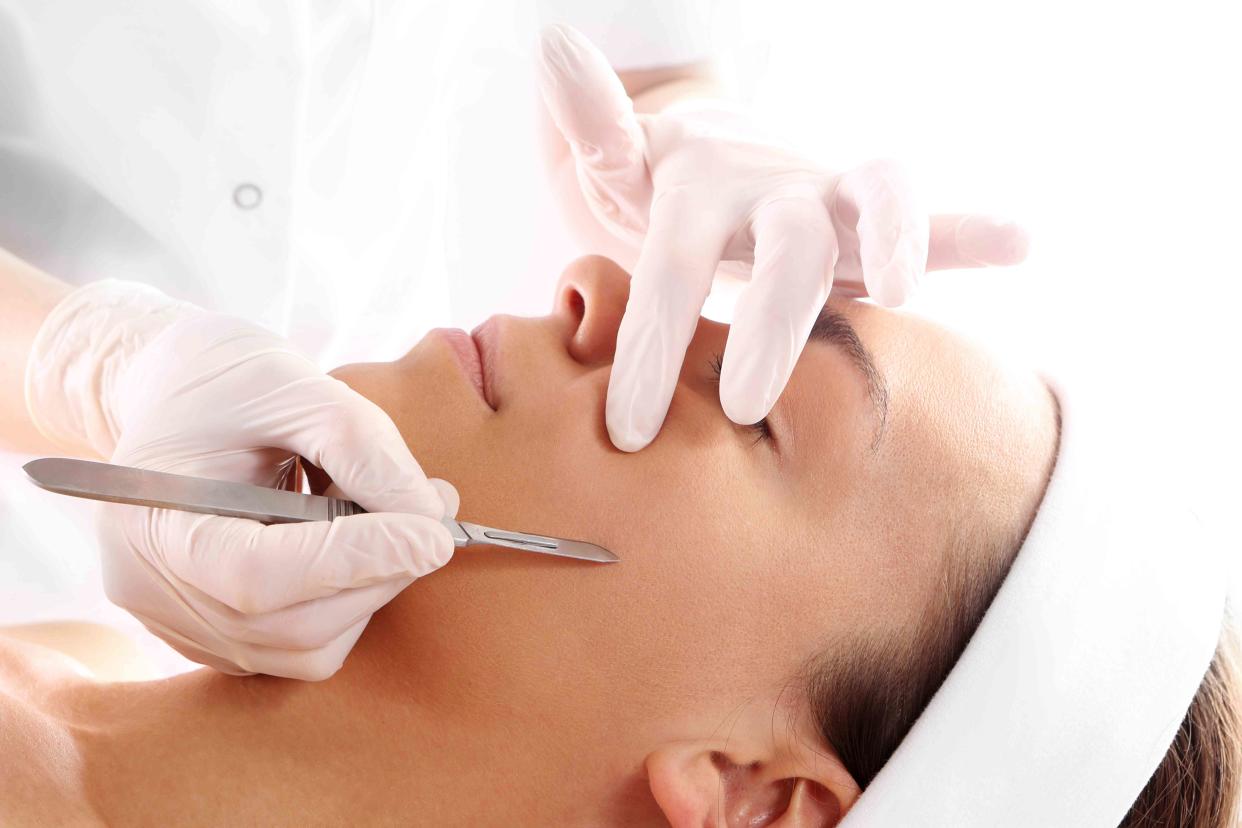The Secret to Dermaplaning Without Nicking Your Skin Is Easier Than You Thought

Getty Images
To dermaplane or not to dermaplane, that is the continuous question that many beauty aficionados seem to have. In fact, the act of shaving the peach face off your face may appear controversial. On one hand, it seems like everyone on TikTok is singing glowing praises of dermaplaning at home. On the other hand, some dermatologists and estheticians are begging skincare newbies to leave dermaplaning to the experts.
But let’s be honest: you’re going to do you. So, if you're thinking about dermaplaning at home, there are a few things you should know. That’s why we asked three skincare experts what the benefits are and how one may go about doing it at home safely. Read on for their recommended protocol.
What is dermaplaning?
“Dermaplaning refers to a minimally invasive treatment to remove the top layers of your skin,” says Dr. Catherine Chang, a board certified plastic and reconstructive surgeon and founder of Privé Beverly Hills. “This helps to exfoliate the skin, as well as remove fine vellus hairs — aka peach fuzz.”
A very sharp metal blade is used to very carefully shave off the top layer of peach fuzz and skin, and it’s a popular treatment used in both spa settings and a doctor’s office. By removing all the peach fuzz and the dead skin cells, your skin will look and feel especially smooth and soft. But there are even better long-term results.
“Dermaplaning can also help with fading the appearance of acne scars and hyperpigmentation, by removing those dead skin cells on top of the skin,” says esthetician Renée Rouleau. And without all the peach fuzz in the way, your skin can receive and absorb your skincare even better. With consistent treatments, Dr. Chang says that your skin texture and brilliance will also improve.
What are the risks of dermaplaning?
With all that being said, dermaplaning still comes with its own risks. As dermaplaning is still an exfoliating treatment, it can be too aggressive for sensitive skin or those with conditions such as dermatitis or eczema. And since dermaplaning is performed with a blade, you’re at risk of possible irritation, discoloration, and acne.
What's the difference between dermaplaning at home and in-office?
The biggest difference between dermaplaning at home and in-office is the level of safety in an office. “In the office, a professional is doing the treatment and has a better global view of your face,” says Dr. Chang. “The professional has more effective instruments, than at-home instruments that have been thoroughly cleaned minimizing change of infection."
However, that’s not to say dermaplaning at home isn’t another great option. In fact, Rouleau says that she’s been dermaplaning at home for years and it has been just as effective as doing it in-office.
Related:The 6 Best At-Home Dermaplaning Tools for Smooth, Fuzz-Free Skin
How to dermaplane at home:
Prep your skin. Dr. Chang, Rouleau, and founder of Dermaflash, Dara Levy, all emphasize the importance of having cleansed and completely dry skin before you pick up your dermaplaning tool of choice.
Pick a safe dermaplaning tool. “Open razor blades leave your skin vulnerable to nicks and cuts,” Levy points out. She recommends using her brand's Dermaflash Luxe+ for optimal safety.
Get close to a mirror. To make sure you can see all the peach fuzz you want to target, Levy suggests situating yourself in front of a magnifying mirror in a well-lit area.
Gently move the blade downward in the direction of your hair growth. “Use a finger from the opposite hand to gently hold your skin taut and hold the device at a 45-degree angle,” Levy instructs. “Use short feathery strokes over the surface of your skin, avoiding your lips, nose, and eyelids.” Furthermore, Rouleau recommends only going over the same area a few times to prevent irritating your skin.
Apply gentle skincare. Keep your freshly-exfoliated skin protected by applying a soothing moisturizer and sunscreen.
For more InStyle news, make sure to sign up for our newsletter!
Read the original article on InStyle.

